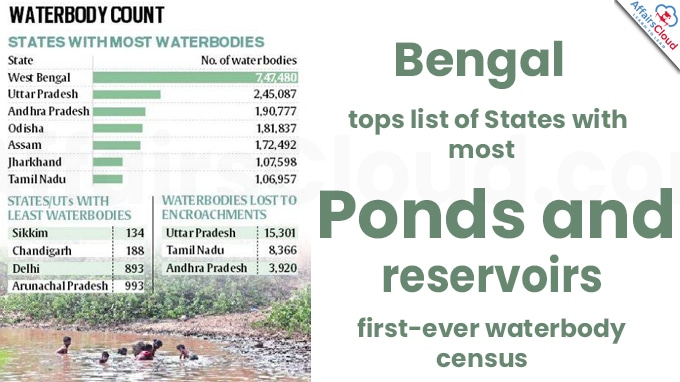 According to the “Water Bodies – 1st Census Report” released by the Ministry of Jal Shakti, West Bengal(WB) has topped the list of states with the most number of ponds and reservoirs. Tamil Nadu has highest number of lakes, Andhra Pradesh (AP) has the highest number of tanks and Maharashtra is the leading state with water conservation schemes.
According to the “Water Bodies – 1st Census Report” released by the Ministry of Jal Shakti, West Bengal(WB) has topped the list of states with the most number of ponds and reservoirs. Tamil Nadu has highest number of lakes, Andhra Pradesh (AP) has the highest number of tanks and Maharashtra is the leading state with water conservation schemes.
- India has 24.24 lakh water bodies such as ponds, tanks and lakes with West Bengal accounting for the most (7.47 lakh) and Sikkim the least (134).
Note:
The water bodies census was conducted along with the 6th Minor Irrigation Census for 2017-18 under the Centrally Sponsored Scheme “Irrigation Census”.
Only less than 3% of the total water available on the earth is fresh water, of which about 75.2% lies frozen in polar regions and another 22.6% is present as ground water.
Click here for Water Bodies – 1st Census Report Volume 1 and Volume 2.
What is a Water body?
i.The report defines a water body as a ‘natural or man-made unit bounded on all sides with some or no masonry works used for storing water for irrigation or other purposes like industrial, pisciculture, domestic/drinking, recreation, religious, groundwater recharge.
- Types of water bodies: tanks, reservoirs, ponds and bundhies and others.
ii.The report states that a structure where water from ice-melt, streams, springs, rain or drainage of water from residential or other areas is accumulated or water is stored by diversion from a stream, nala or river will also be treated as water body.
Account of Indian Water bodies:
i.According to the report, 24,24,540 water bodies have been enumerated in India of which around 97.1% (~23,55,055) water bodies are in rural areas and only 2.9%(~69,485) water bodies are in urban areas.
ii.Around 59.5% (14,42,993) of water bodies in India are ponds, followed by tanks – 15.7% (3,81,805), reservoirs – 12.1% (2,92,280), water conservation schemes/percolation tanks/check dams – 9.3% (2,26,217), lakes – 0.9% (22,361) and others – 2.5% (58,884).
iii.A major proportion of water bodies i.e., 83.7% (20,30,040) are in use whereas remaining 16.3% (3,94,500) are not in use on account of drying up, construction, siltation, destroyed beyond repair, salinity and other reasons.
iv.More than 3,94,500 water bodies are not in use on account of drying up, construction, siltation, destroyed beyond repair, salinity and other reasons.
v.Around 55.2% (13,38,735) of water bodies are owned by private entities whereas 44.8% (10,85,805) are under public ownership.
Key Points:
i.With 3.55 lakh waterbodies, South 24 Parganas of West Bengal is ranked as the top district with the highest number of waterbodies across India.
ii.The top 5 states (in number of water bodies) are, West Bengal (30.8% i.e., 747480) followed by Uttar Pradesh(10.1% i.e., 245087), Andhra Pradesh(7.9% i.e., 190777), Odisha 7.5% i.e., 181837) and Assam (7.1% i.e., 172492).
iii.The census also collected data on the encroachment of waterbodies for the first time. 1.6% of water bodies out of all the enumerated waterbodies are reported to be encroached, out of which 95.4% are in rural areas and the remaining 4.6% in urban areas.
iv.Out of all encroached waterbodies, 62.8% have less than 25% area under encroachment, whereas 11.8% waterbodies have more than 75% area under encroachment.
About Ministry of Jal Shakti:
Union Minister– Gajendra Singh Shekhawat(Constituency- Jodhpur, Rajasthan)
Minister of State– Bishweswar Tudu(Constituency- Mayurbhanj, Odisha); Prahlad Singh Patel(Constituency- Damoh, Madhya Pradesh)




